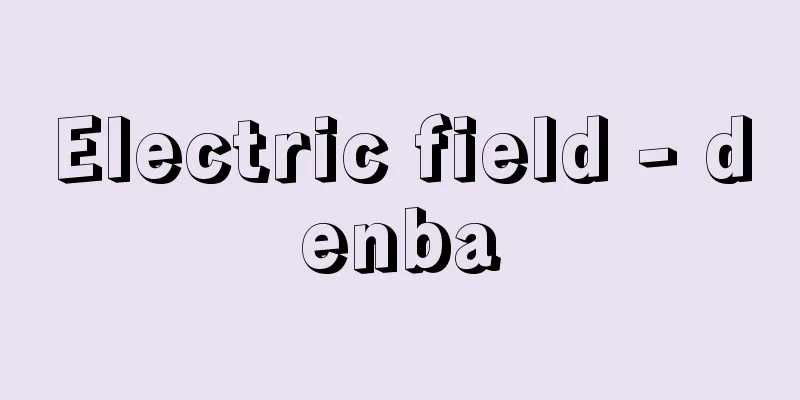Electric field - denba

|
The electrical force acting at any point in space is called the electric field or electric field at that point. An electric field that is independent of time is called an electrostatic field. We will explain this below. First, assume that the space is a vacuum. When the distance between two stationary charges q 1 and q 2 is r , the force F acting between the two charges is given by F = kq 1 q 2 / r 2. F is a repulsive force when q 1 and q 2 have the same sign, and an attractive force when they have opposite signs. This is called Coulomb's law. The force F is called the electrostatic force or electrostatic Coulomb force. The proportionality constant k differs depending on the unit system. In the non-rational electrostatic unit system, k = 1. In the MKSA unit system, k = 1/(4πε 0 ). ε 0 is the dielectric constant of vacuum, and has a value of 8.854×10 -12 in farads/meter. The unit of charge q is the coulomb, and the unit of distance r is the meter, and using these units, F = q 1 q 2 /(4πε 0 r 2 ). In recent years, the MKSA system of units has generally been used, especially in electrical engineering. In general, various charges are distributed at various positions in space. Now, let us assume that all these charges are stationary. Then, we insert another so-called probing charge q 0 into the space. The force acting on this q 0 is the sum of the Coulomb forces (vectors) acting between q 0 and all other charges, which is obviously proportional to q 0. In particular, when q 0 =1, the force acting on this charge is the electric field at the position of this charge. The electric field is obviously a vector. (a) and (b) show the electric field generated at each point in space by one positive charge and one negative charge, respectively. At each point in space, the probing charge moves in the direction of the electric field at that point. If we connect these directions, we get a curve. The tangents at each point on this curve represent the direction of the electric field at that point. This curve is called the electric field line. The distribution of the electric field in space can be shown by drawing many such electric field lines. shows the electric field lines when positive and negative charges of equal absolute value are lined up. shows the electric field lines generated by a uniformly positively charged semi-infinite conductor. In a conductor, charge exists only on the surface, and therefore it can be said that no electric field exists inside the conductor. This is because if charge exists inside the conductor, this charge would move due to the internal electric field that arises with it, which contradicts the previous assumption that all charges are stationary. The electrostatic field E is connected to the electric potential or electric field V by E =-grad V =-∇ V. Here, grad≡∇ is a vector operator called gradient. Therefore, the state of E in space can also be expressed by V. A curved surface that connects points with the same V is called an equipotential surface. In , the dashed lines represent equipotential surfaces. The above was the case when the space was a vacuum, but inside a material, the Coulomb force is F = q 1 q 2 /(4πεε 0 ) r 2 , and therefore the electric field is E = E 0 /ε. However, E 0 is the electric field in a vacuum, and ε is a material constant called the dielectric constant. ε is always greater than 1, and therefore E < E 0 is always true. When an electric field E exists in a space, electrostatic energy determined by this E is stored in the space. The electrostatic energy u per unit volume is given by u =(1/2)εε 0 E 2 , when the dielectric constant of the space is ε. Above, we have explained the electric field generated by a stationary charge, i.e., the electrostatic field. This electrostatic field is generated even when the charge is moving, but in addition to that, when a charge moves, a magnetic field is generated, and when a magnetic field exists, the moving charge is subjected to a force from this. If the magnetic field changes over time, the charge is subjected to a force even if it is stationary. None of these points have been taken into consideration at this point. [Shozo Sawada] [Reference] |©Shogakukan "> Electric field generated by a single charge (Figure A) ©Shogakukan "> Electric field lines due to equal positive and negative charges... ©Shogakukan "> A uniformly positively charged semi-infinite conductor… Source: Shogakukan Encyclopedia Nipponica About Encyclopedia Nipponica Information | Legend |
|
空間内の任意の点に働く電気的な力を、この点の電場または電界という。時間に依存しない電場を静電場という。以下これについて説明する。初めに空間が真空であるとする。二つの静止している電荷q1、q2の間の距離がrであるときに、この二つの電荷の間に働く力FはF=kq1q2/r2で与えられる。Fは、q1、q2が同符号のときは斥力で、異符号のときは引力である。これがクーロンの法則とよばれるものである。力Fは静電力または静電的クーロン力とよばれる。比例定数kは単位系により異なる。非有理静電単位系ではk=1である。MKSA単位系ではk=1/(4πε0)である。ε0は真空の誘電率であり、ファラッド/メートルを単位として、8.854×10-12の数値をとる。電荷qの単位はクーロン、距離rの単位はメートルで、これらの単位を用いて、F=q1q2/(4πε0r2)が成り立つ。近年一般には、とくに電気工学においては、MKSA単位系が使用される。 空間には一般にはいろいろの位置にいろいろの電荷が分布している。いま、これらの電荷はすべて静止しているとする。このとき空間内にさらに一つの、いわゆる探り電荷q0を挿入する。このq0に働く力はq0とすべての他の電荷との間に働くクーロン力(ベクトル)の総和であるが、これは明らかにq0に比例する。とくにq0=1のとき、この電荷に働く力がこの電荷の位置の電場である。電場は明らかにベクトルである。(a)・(b)は、それぞれ1個の正電荷および負電荷によって空間の各点に生じる電場を示す。探り電荷は、空間の各点において、そこの電場の方向、向きに移動する。この方向、向きを連ねていくと一つの曲線が得られる。この曲線上の各点での接線はその点の電場の方向、向きを表す。この曲線を電気力線という。空間内の電場の分布はこのような電気力線を多数書くことによって示すことができる。は絶対値が等しい正負の電荷が並んでいる場合の電気力線のようすをしめす。は一様に正に帯電した半無限大導体によって生じる電気力線を示す。導体では電荷は表面にしかなく、これに伴って導体の内部には電場は存在しないことがいえる。それは、もし導体の内部に電荷が存在すれば、それに伴って生じる内部の電場によってこの電荷は移動することとなり、すべての電荷が静止しているとしているただいまの前提に反するからである。静電場Eは電気ポテンシャルまたは電位VとE=-gradV=-∇Vでつながっている。ここにgrad≡∇は勾配(こうばい)とよばれるベクトル演算子である。したがって、空間におけるEのようすはVによっても表すことができる。Vが等しい点を連ねた曲面を等電位面という。において破線は等電位面を表す。 以上は空間が真空の場合であったが、物質の中では、クーロン力はF=q1q2/(4πεε0)r2となり、したがって電場はE=E0/εとなる。ただし、E0は真空の場合の電場であり、εは誘電率とよばれる物質定数である。εはかならず1よりは大きく、したがってつねにE<E0である。空間に電場Eが存在すると、空間にこのEで決まる静電エネルギーが蓄えられる。単位体積当りの静電エネルギーuは、空間の誘電率がεのとき、u=(1/2)εε0E2で与えられる。 以上、静止している電荷によって生じる電場、すなわち静電場について説明した。電荷が運動していても、この静電場は生じるが、それ以外に、電荷が運動すると磁場が発生し、また、磁場が存在すると、運動する電荷はこれから力を受ける。磁場が時間的に変化すると、電荷が静止していても力を受ける。これらのことは、すべてただいまは考慮されていない。 [沢田正三] [参照項目] |©Shogakukan"> 1個の電荷によって生じる電場〔図A〕 ©Shogakukan"> 絶対値が等しい正負の電荷による電気力線… ©Shogakukan"> 一様に正に帯電している半無限大導体によ… 出典 小学館 日本大百科全書(ニッポニカ)日本大百科全書(ニッポニカ)について 情報 | 凡例 |
<<: Denver - Denver (English spelling)
Recommend
Pilea cadierei (English spelling) Pilea cadierei
…[Tetsuichi Yahara]. … From [Pilea] … [Takabayash...
Quotation marks - info
A symbol used to indicate a quotation when posting...
Cross Gorge
A local beer produced by Unazuki Beer Co., Ltd. in...
Enzan
...One of the six major head temples of the Jodo ...
Kun-qu (English spelling)
A school of classical Chinese drama. Also called &...
lame
A fabric made by weaving patterns using gold or si...
Drug interactions - Drug interactions
Drug interactions when multiple drugs are used tog...
Takuma [town] - Takuma
A former town in Mitoyo County in western Kagawa P...
Iruka - Dolphin
The title of a Kōwaka dance piece. Also known as K...
Wu Yao-zong
[Born] Guangxu 19 (1893). Guangdong, Shunde [Dead]...
Mobilization - Douin
〘noun〙① The transfer of the human and material res...
Yoshino [town] - Yoshino
A town in Yoshino County, central Nara Prefecture....
Cupellation - Haifukigin
This refers to silver produced by the cupellation ...
Isehara [city] - Isehara
A city in central Kanagawa Prefecture, located at ...
Aphrodite
…He was familiar with ancient Greek literature fr...

![Mikata [town] - Mikata](/upload/images/67ccef361f627.webp)

![Kii-Nagashima [town] - Kii-Nagashima](/upload/images/67cb4e00aed74.webp)





